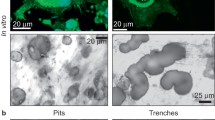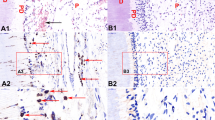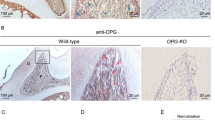Abstract
Dental disease due to osteoclast (OC) overactivity reaches epidemic proportions in older domestic cats and has also been reported in wild cats. Feline odontoclastic resorptive lesions (FORL) involve extensive resorption of the tooth, leaving it liable to root fracture and subsequent loss. The etiopathogenesis of FORL remains unclear. Here, we explore the hypothesis that FORL is associated with hypoxia in the oral microenvironment, leading to increased OC activity. To investigate this, we developed a method of generating OCs from cat blood. Reducing O2 from 20% to 2% increased the mean area of OC eightfold from 0.01 to 0.08 mm2. In hypoxic cultures, very large OCs containing several hundred nuclei were evident (reaching a maximum size of ∼14 mm2). Cultures exposed to 2% O2 exhibited an increase of ∼13-fold in the area of bone slices covered by resorption lacunae. In line with this finding, there was a significant increase in cells differentiating under hypoxic conditions, reflected in increased expression of cathepsin K and proton pump enzymes. In conclusion, these results demonstrate that oxygen tension is a major regulator of OC formation in the cat. However, in this species, hypoxia induces the formation of “giant” OCs, which can be so large as to be visible with the naked eye and yet also actively resorb. This suggests that local hypoxia is likely to play a key role in the pathogenesis of FORL and other inflammatory conditions that are associated with bone resorption in cats.




Similar content being viewed by others
References
Arnett T (2003) Regulation of bone cell function by acid-base balance. Proc Nutr Soc 62:511–520
Arnett TR, Dempster DW (1986) Effect of pH on bone resorption by rat osteoclasts in vitro. Endocrinology 119:119–124
Arnett TR, Spowage M (1996) Modulation of the resorptive activity of rat osteoclasts by small changes in extracellular pH near the physiological range. Bone 18:277–279
Meghji S, Henderson B, Morrison MS, Arnett TR (2001) pH dependence of bone resorption: mouse calvarial osteoclasts are activated by acidosis. Am J Physiol 280:E112–E119
Arnett TR, Gibbons DC, Utting JC, Orriss IR, Hoebertz A, Rosendaal M, Meghji S (2003) Hypoxia is a major stimulator of osteoclast formation and bone resorption. J Cell Physiol 196:2–8
Liu RS, Chu LS, Yen SH, Chang CP, Chou KL, Wu LC, Chang CW, Lui MT, Chen KY, Yeh SH (1996) Detection of anaerobic odontogenic infections by fluorine-18 fluoromisonidazole. Eur J Nucl Med 23:1384–1387
Lewis JS, Lee JA, Underwood JC, Harris AL, Lewis CE (1999) Macrophage responses to hypoxia: relevance to disease mechanisms. J Leukocyte Biol 66:889–900
Bradley TR, Hodgson GS, Rosendaal M (1978) The effect of oxygen tension on haemopoietic and fibroblast cell proliferation in vitro. J Cell Physiol 97:517–522
Broxmeyer HE, Cooper S, Lu L, Miller ME, Langefeld CD, Ralph P (1990) Enhanced stimulation of human bone marrow macrophage colony formation in vitro by recombinant human macrophage colony-stimulating factor in agarose medium and at low oxygen tension. Blood 76:323–329
Koller MR, Bender JG, Miller WM, Papoutsakis ET (1992) Reduced oxygen tension increases hematopoiesis in long-term culture of human stem and progenitor cells from cord blood and bone marrow. Exp Hematol 20:264–270
Lonmer MJ, Verstraete FJ (2000) Prevalence of odontoclastic resorption lesions and peripheral radiographic lucencies in cats: 265 cases (1995–1998) J Am Vet Med Assoc 217:1866–1869
Heaton M, Wilkinson J, Gorrel C, Butterwick R (2004) A rapid screening technique for feline odontoclastic resorptive lesions. J Small Anim Pract 45:598–601
Gengler W, Dubielzig R, Ramer J (1995) Physical examination and radiographic analysis to detect dental and mandibular bone resorption in cats: a study of 81 cases from necropsy. J Vet Dent 12:97–100
Lyon KF (1992) Subgingival odontoclastic resorptive lesions: classification, treatment, and results in 58 cats. Vet Clin North Am Small Anim Pract 22:1417–1432
Liang H, Burkes EJ, Frederiksen NL (2003) Multiple idiopathic cervical root resorption: systematic review and report of four cases. Dentomaxillofac Radiol 32:150–155
Okuda A, Harvey CE (1992) Etiopathogenesis of feline dental resorptive lesions. Vet Clin North Am Small Anim Pract 22:1385–1404
Reiter AM, Mendoza KA (2002) Feline odontoclastic resorptive lesions: an unsolved enigma in veterinary dentistry. Vet Clin North Am Small Anim Pract 32:791–837
DeLaurier A, Allen S, deFlandre C, Horton MA, Price JS (2002) Cytokine expression in feline osteoclastic resorptive lesions. J Comp Pathol 127:169–177
Muzylak M, Flanagan AM, Ingham K, Gunn N, Price J, Horton MA (2002) A feline assay using osteoclasts generated in vitro from peripheral blood for screening antiresorptive agents. Res Vet Sci 73:283–290
Horton MA, Nesbitt SA, Bennett JH, Stenbeck G (2002) Integrins and other cell surface attachment molecules of bone cells. In: Bilezikian JP, Raisz LG, Rodan GA (eds), Principles of Bone Biology, 2nd ed. Academic Press, San Diego, pp 265–286
Lader CS, Flanagan AM (1998) Prostaglandin E2, interleukin 1α, and tumor necrosis factor- increase human osteoclast formation and bone resorption in vitro. Endocrinology 139:3157–3164
Massey HM, Flanagan AM (1999) Human osteoclasts derive from CD14-positive monocytes. Br J Haematol 106:167–170
Lader CS, Scopes J, Horton MA, Flanagan AM (2001) Generation of human osteoclasts in stromal cell-free and stromal cell-rich cultures: differences in osteoclast CD11c/CD18 integrin expression. Br J Haematol 112:430–437
Nesbitt SA, Horton MA (1997) Trafficking of matrix collagens through bone-resorbing osteoclasts. Science 276:266–269
Horton MA, Lewis D, McNulty K, Pringle JA, Chambers TJ (1985) Monoclonal antibodies to osteoclastomas (giant cell bone tumours): definition of osteoclast-specific cellular antigens. Cancer Res 45:5663–5669
Horton MA, Massey HM, Rosenberg N, Nicholls B, Seligsohn U, Flanagan AM (2003) Upregulation of osteoclast α2β1 integrin compensates for lack of αvβ3 vitronectin receptor in Iraqi-Jewish-type Glanzmann thrombasthenia. Br J Haematol 122:950–957
Bennett D (1995) Diseases of the musculoskeletal system. In: Chandler EA, Gaskell CJ, Gaskell RM (eds), Feline Medicine and Therapeutics. Blackwell Science, Oxford, pp 150–191
Clark L (1970) The effect of excess vitamin A on long bone growth in kittens. J Comp Pathol 80:625–634
Barber PJ, Elliott J (1998) Feline chronic renal failure: calcium homeostasis in 80 cases between 1992 and 1995. J Small Anim Pract 39:108–116
Heldmann E, Anderson MA, Wagner-Mann C (2000) Feline osteosarcoma: 145 cases (1990–1995). J Am Anim Hosp Assoc 36:518–521
Hill FWG (1977) A survey of bone fractures in the cat. J Small Anim Pract 18:457–463
Addison WC (1978) Enzyme histochemical properties of kitten osteoclasts in bone imprint preparations. Histochem J 10:645–656
Allen TD, Testa NG, Suda T, Schor SL, Onions D, Jarrett O, Boyde A (1981) The production of putative osteoclasts in tissue culture – ultrastructure, formation and behaviour. Scanning Electron Microsc 3:347–354
Ibbotson KJ, Roodman GD, McManus LM, Mundy GR (1984) Identification and characterization of osteoclast-like cells and their progenitors in cultures of feline marrow mononuclear cells. J Cell Biol 99:471–480
Pharoah MJ, Heersche JN (1985) 1,25-Dihydroxyvitamin D3 causes an increase in the number of osteoclast like cells in cat bone marrow cultures. Calcif Tissue Int 37:276–281
Horton MA, Fowler P, Simpson A, Onions D (1988) Monoclonal antibodies to human antigens recognise feline myeloid cells. Vet Immunol Immunopathol 18:213–217
Massey HM, Scopes J, Horton MA, Flanagan AM (2001) Transforming growth factor-beta1 (TGF-β) stimulates the osteoclast-forming potential of peripheral blood hematopoietic precursors in a lymphocyte-rich microenvironment. Bone 28:577–582
Addison WC (1980) The effect of parathyroid hormone on the numbers of nuclei in feline odontoclasts in vivo. J Periodontal Res 15:536–543
De Vico G, Maiolino P (1997) “Osteoclast-like” giant cells in a feline mammary carcinoma. J Submicrosc Cytol Pathol 29:153–155
Reddy SV, Menaa C, Singer FR, Demulder A, Roodman GD (1999) Cell biology of Paget’s disease. J Bone Miner Res (suppl 2):3–8
Muzylak M, Arnett TR, Price J, Horton MA (2004) The effect of pH on osteoclast function in the cat. Bone 34:S25–S47
Martin GR, Jain RK (1994) Non-invasive measurement of interstitial pH profiles in normal and neoplastic tissue using fluorescence ratio imaging microscopy. Cancer Res 54:5670–5674
Ivanovic Z, Hermitte F, de la Grange PB, Dazey B, Belloc F, Lacombe F, Vezon G, Praloran V (2004) Simultaneous maintenance of human cord blood SCID-repopulating cells and expansion of committed progenitors at low O2 concentration (3%). Stem Cells 22:716–724
Chen EH, Olsen EN (2005) Unveiling the mechanisms of cell fusion. Science 308:369–373
Kudo Y, Boyd CA, Sargeant IL, Redman CW (2003) Hypoxia alters expression and function of syncytin and its receptor during trophoblast cell fusion of human placental BeWo cells: implications for impaired trophoblast syncytialisation in pre-eclampsia. Biochim Biophys Acta 1638:63–71
Bruick RK, McKnight SL (2001) A conserved family of prolyl-4-hydroxylases that modify HIF. Science 294:1337–1340
Jaakkola P, Mole DR, Tian YM, Wilson MI, Gielbert J, Gaskell SJ, Kriegsheim AV, Hebestreit HF, Mukherji A, Schofield CJ, Maxwell PH, Pugh CW, Ratcliffe PJ (2001) Targeting of HIF-α to the von Hippel-Lindau ubiquitylation complex by O2-regulated prolyl hydroxylation. Science 292:468–472
Bodin P, Burnstock G (1995) Synergistic effect of acute hypoxia on flow-induced release of ATP from cultured endothelial cells. Experientia 51:256–259
Morrison M, Turin L, King BF, Burnstock G, Arnett TR (1998) ATP is a potent stimulator of the activation and formation of rodent osteoclasts. J Physiol 511:495–500
Hoebertz A, Townsend-Nicholson A, Burnstock G, Arnett TR (2000) Expression of P2 receptors in bone and cultured bone cells. Bone 27:503–510
Hoebertz A, Meghji S, Burnstock G, Arnett TR (2001) Extracellular ADP is a powerful osteolytic agent: evidence for signaling through the P2Y1 receptor on bone cells. FASEB J 15:1139–1148
Hasegawa K, Ichiyama T, Isumi H (2003) NF-κB activation in peripheral blood mononuclear cells in neonatal asphyxia. Clin Exp Immunol 132:261–264
Lubec B, Labudova O, Hoeger H, Kirchner L, Lubec G (2002) Expression of transcription factors in the brain of rats with perinatal asphyxia. Biol Neonate 81:266–278
Simmons HA, Raisz LG (1991) Effects of acid and basic fibroblast growth factor and heparin on resorption of cultured fetal rat long bones. J Bone Miner Res 6:1301–1305
Nakagawa N, Yasuda H, Yano K, Mochizuki S, Kobayashi N, Fujimoto H, Shima N, Morinaga T, Chikazu D, Kawaguchi H, Higashio K (1999) Basic fibroblast growth factor induces osteoclast formation by reciprocally regulating the production of osteoclast differentiation factor and osteoclastogenesis inhibitory factor in mouse osteoblastic cells. Biochem Biophys Res Commun 265:158–163
Nakagawa M, Kaneda T, Arakawa T, Morita S, Sato T, Yomada T, Hanada K, Kumegawa M, Yakeda Y (2000) Vascular endothelial growth factor (VEGF) directly enhances osteoclastic bone resorption and survival of mature osteoclasts. FEBS Lett 473:161–164
Akeno N, Czyzyk-Krzeska MF, Gross TS, Clemens TL (2001) Hypoxia induces vascular endothelial growth factor gene transcription in human osteoblast-like cells through the hypoxia-inducible factor-2α. Endocrinology 142:959–962
Steinbrech DS, Mehrara BJ, Saadeh PB, Chin G, Dudziak ME, Gerrets RP, Gittes GK, Longaker MT (1999) Hypoxia regulates VEGF expression and cellular proliferation by osteoblasts in vitro. Plast Reconstr Surg 104:738–747
Steinbrech DS, Mehrara BJ, Saadeh PB, Greenwald JA, Spector JA, Gittes GK, Longaker MT (2000) VEGF expression in an osteoblast-like cell line is regulated by a hypoxia response mechanism. Am J Physiol 278:C853–C860
Steinbrech DS, Mehrara BJ, Saadeh PB, Greenwald JA, Spector JA, Gittes GK, Longaker MT (2000) Hypoxia increases insulin-like growth factor gene expression in rat osteoblasts. Ann Plast Surg 44:529–535
Warren SM, Steinbrech DS, Mehrara BJ, Saadeh PB, Greenwald JA, Spector JA, Buletreau PJ, Longaker MT (2001) Hypoxia regulates osteoblast gene expression. J Surg Res 99:147–155
Hill PA, Reynolds JJ, Meikle MC (1995) Osteoblasts mediate insulin-like growth factor-I and -II stimulation of osteoclast formation and function. Endocrinology 136:124–131
Fuller K, Lean JM, Bayley KE, Wani MR, Chambers TJ (2000) A role for TGFβ1 in osteoclast differentiation and survival. J Cell Sci 113:2445–2453
Acknowledgment
This work was carried out with the financial help of a grant from the Waltham Centre for Pet Nutrition (Waltham-on-the-Wolds, UK). M. A. H. is supported by a program grant from The Wellcome Trust. The authors are grateful for the expert advice and help of Timothy Arnett, Jenny Utting, and Andrea Brandao-Burch (University College London).
Author information
Authors and Affiliations
Corresponding author
Rights and permissions
About this article
Cite this article
Muzylak, M., Price, J.S. & Horton, M.A. Hypoxia Induces Giant Osteoclast Formation and Extensive Bone Resorption in the Cat. Calcif Tissue Int 79, 301–309 (2006). https://doi.org/10.1007/s00223-006-0082-7
Received:
Accepted:
Published:
Issue Date:
DOI: https://doi.org/10.1007/s00223-006-0082-7




